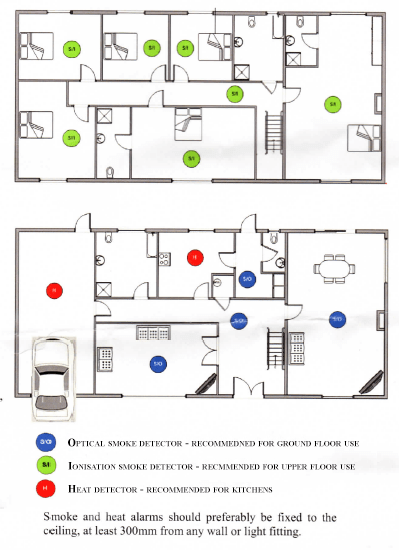Technical Dcoument B Volume 2 applies to works to dwelling houses, or buildings in which a material change of use takes place, where the works or the change of use commence or takes place, as the case may be, on or after 1 July 2017.
The 2017 TD'B' (volume 2) standard provides guidance on the provision of fire detection and alarm systems in dwellings. It refers to different grades and types of fire detection and alarm systems, which can provide varying levels of protection. TDB should be read in conjunction with the I.S. 3218 (2013) Fire alarm standard.
Section 10 of the IS3218 deals with residential systems.
The minimum level of protection for a house up to 3 storeys is an LD2 system as shown in a typical example on the diagram below.

For dwellings larger than set out above or higher than three storeys, an LD1 system may be required. Category LD1 includes all those areas specified in LD2 but also includes all rooms and areas (including attics/lofts/other spaces) in which fire might start, other than toilets, bathrooms and shower rooms.
LD2 REQUIREMENT (guide)
- All circulation areas that form part of an escape route within the dwelling and
- All high fire risk areas/rooms e.g. kitchen, living rooms, garages, utility rooms and
- All bedrooms
The purpose of the requirement is to ensure that adequate early warning of fire is provided and a satisfactory standard of means of escape is provided for persons in the event of fire in a building.
A Grade D system would be the minimum acceptable for a standard domestic installation. This consists of self-contained mains-powered smoke or heat alarms each provided with an integral standby power supply. Where multiple units are provided all devices shall be interconnected so that detection of fire by any one unit will provide an audible alarm from each unit. For Grade D installations interconnections may be by radio or wiring.
CERTIFICATION
A Certificate of Commissioning
shall be issued. The procedure for certifying a dwelling house fire alarm system is to print the details of the model certificate as shown in Annex K of the IS3218 onto the design company's headed paper.
NOTE: This information is intended as a guideline only. Please read the documents listed below to ensure that you are in full compliance.
The IS3218 2013 can be obtained via the
NSAI website or purchased from Safe Electric.
Electrical Wholesaler supply a full range of
fire, safety and security products. If you have a paerticular need, don't hesitate to
contact us.